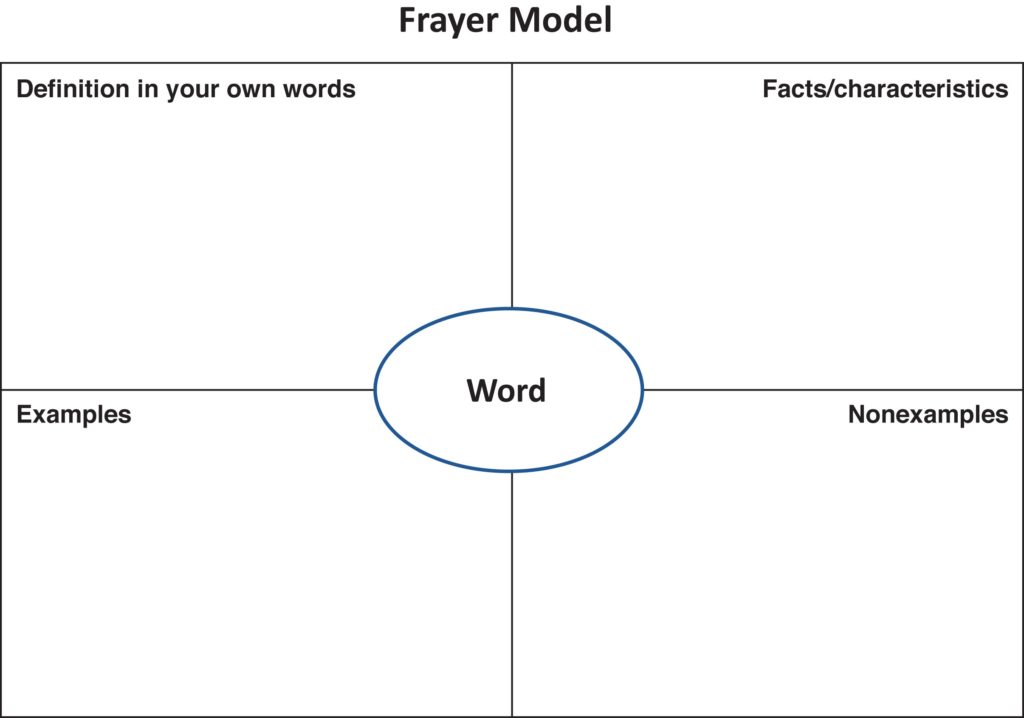Contents
DROP-IN-WORDS
Pre-teaching unfamiliar words is time-consuming and in most cases ineffective. Use the drop-in definitions routine instead to define most unfamiliar words while reading a text aloud. When reading a passage aloud, pause briefly when encountering the unfamiliar word or term to say what it means. Continue reading without discussion.
Example: When reading “There was a range of mountains,” say “That means a lot of mountains next to each other,” and then continue reading.
Drop-In definitions are not appropriate for words that require long definitions or discussion, such as government, slavery, or photosynthesis, as this definition would interrupt the read aloud. Words of this type should be pre-taught before reading.
FRAYER
The Frayer Chart provides a way for students to think about and categorize new vocabulary that is aligned with Marzano, and is best reserved for either high-impact tier 2 words or tier 3 words reflecting overarching concepts (such as photosynthesis.) Provide a Frayer Chart to students and encourage them to use it to build meaning for such words.

| TYPE OF VOCABULARY | GUIDANCE | RATIONALE |
|---|---|---|
| Literary terms | These terms are listed in the Module Overview. Provide explicit instruction in these terms when they appear in lessons. Check for student understanding by having students define words, or by having them complete a Frayer chart, or by playing a matching game. | Understanding academic vocabulary is key to doing well on formal assessments. Otherwise, students may supply a plot when asked for a theme, or may answer how instead of why. |
| Text-specific Tier 2 and 3 words | If words are essential to getting the gist, but are simple to explain, plan to define them during reading. For texts that are read aloud, this can be accomplished with a Drop-In Definition (simply provide the definition or synonym in the midst of reading without further discussion) or by providing a Glossary for students to use.
If words are essential to gist but are complex to explain or target sensitive topics, then preteach using one of the methods below.
You can define other words later, or support students through using context clues and/or word part knowledge (see below.) | It is important to read a text straight through during Read for Gist in order to support comprehension and engagement. You can define many words simply as an aside (“ranges…that means many mountains”) without breaking the narrative momentum of a text. |
| Words for Preteaching | Provide student-friendly definitions. Provide images. Give students opportunities to talk about the words. (They should use the words when they talk.) Play matching games with words and definitions or words and pictures. | The more times and in the more variety of contexts that students encounter a word, the better they will remember and understand it. |
| Words defined using Context Clues | Teach students to use the information surrounding a word to infer what it might mean. Ask them to think, “What makes sense?” | |
| Words defined using word part knowledge | Consider posting a chart with common word roots to aid in defining words. | Greek and Latin word roots are especially helpful when defining words in scientific and historical texts. Beginning in grade 3, word root knowledge is a language skill expectation of the Common Core State Standards. |
| Tier 3 (Topic-specific Words) | Add to a word wall or create an anchor chart of important topic-specific words for students to use during speaking and writing. Before any partner or class discussion, tell or elicit from students what words should be used in conversation. | Oral language helps cement understanding of words and prepares students for reading and writing with those words. This oral component is especially important for English Language learners. |
INSIDE OUT STRATEGY
This strategy combines context clues with word knowledge to help readers deduce a word’s meaning. Share and model the strategy for students to support their work with tier 2 and tier 3 vocabulary.
- Look inside the word and separate it into prefixes, suffixes, and word roots.
Misconception= mis + concept + tion - Determine meanings from each of the word parts.
- mis means “wrong”
- concept means “idea”
- tion creates a noun
- Put the meanings together: misconception means “a wrong idea”
- Look outside the word for context clues that add to or reinforce the word’s meaning.
- “It is a misconception to think the moon goes around the Earth in a single day. In reality, it takes a month.”
- Context clue: in reality means that the passage before it is wrong. This clue confirms the inside meaning that a misconception is a wrong idea.
SAY IT, COVER IT, RESAY IT
(also see Annotation and Response: Say It Cover It, Resay It for other ways to use this routine)
Use this routine in reading to help students express their understandings of an unfamiliar word’s meaning. Have students read a chunk of text containing the unfamiliar word, then cover it with a hand or piece of paper, and resay what the word means in their own words.
TIER 2 AND TIER 3 VOCABULARY
Definitions
Tier 1 words are basic words used in common discourse that typically need no definition for native English speakers. Sometimes colloquially referred to as “playground” words, this category includes words in general use, such as mother, house, friend, airplane, happy, sad, eat, run, house, like, etc. Occasionally Tier 1 words are also domain-specific—required to understand a particular topic—and can therefore be categorized as Tier 3 even though they will be familiar to most students. Examples include rainbow and thunderstorm.
Tier 2 words are words that students will encounter in a variety of contexts. For this reason, they are considered to be high-impact words, and are the words that research indicates teachers should spend the most instructional time developing. They include:
- Nuanced versions of tier 1 words (e.g. strutted, stomped, and slithered for walked or went; whispered, crooned, uttered, or announced for said).
- Words with multiple meanings in different domains or contexts (e.g. form, reproduce, stamp, multiply, form, structure, cell).
- Academic vocabulary (e.g. infer, explain, identify)
Tier 3 words are specialized words that belong to and have one meaning in aspecific domain (e.g. chlorophyll, carburetor, sine curve, cytoplasm, judicial, lava, DNA). You should define these words for students, but the balance of instruction should favor tier 2.
Instructional Use
Tier 2 words provide nuanced ways of expression for students and the capacity to differentiate these meanings in reading texts. Since Tier 3 words are topic or domain-specific, they help students understand readings based in such topics. Teachers can incorporate both word tiers in many ways to reinforce them and support students’ internalization.
Try these ideas or create your own:
- Have students star unfamiliar words on Handout 1A and check words they recognize. Briefly preview the unfamiliar words.
- Use a product such as Quizlet to create vocabulary flash cards to support students learning difficult words
- Offer students the option or require them to use a tier 2 and tier 3 word in a TDQ answer.
- Offer students the option or require them to incorporate some tier 2 and tier 3 words as they draft a focus writing task.
To learn more about Tier 2 and Tier 3 words,
- Visit Achieve the Core for both research-based articles and a web-based tool for locating tier 2 words: http://achievethecore.org/page/1027/academic-word-finder.
- Visit Common Core to read research about tier 2 and tier 3 words on pp. 32-35 of Appendix A: http://www.corestandards.org/assets/Appendix_A.pdf.
To make your own tier 2 and tier 3 Words Handout, use the template that follows. If you will be using a Vocabulary skill mini-lesson to teach any of the words on your new handout, omit the definition for these words. Have students add the definition to their handout after defining the word during vocabulary skill instruction.
Handout: Tier 2 and Tier 3 Words
Directions: Use these words as you read to help you develop a more precise vocabulary and understand a specific topic.
| TIER 2 WORDS | |
|---|---|
| word | (p.#): definition |
|
|
| TIER 3 WORDS | |
|---|---|
| word | (p.#): definition |
|
|
WORD-SOLVING STRATEGIES
- Ask “What makes sense?”
- Look at surrounding information (context clues) to infer meaning.
- Use word part knowledge. Is there any part of the word you recognize? Break the word into syllables and look at:
- Prefixes (anti, a, mis, dis, non = not; pre = before; con = with; trans = across)
- Word roots
- Ask, “Do I need to know this word to understand the gist?” If not, keep reading and come back later.
- Look up the definition using a glossary or dictionary.
WORD WALLS
A word wall offers a way to display instructional and domain-specific vocabulary that students may need for speaking and writing. Display words alphabetically at a size that seated students can read. See some examples here. If desired, words can be color-coded in categories such as topic-specific and general use (e.g. Weather Words and General Words when studying weather), or parts of speech (e.g. Adjectives, Nouns, verbs.) To make room for new words, remove domain-specific words from the word wall when you introduce a new topic and general-use words when most students correctly spell and use them.
A word wall is enormously useful as a permanent display since it provides visual reinforcement of word knowledge. If space is an issue, it can also be mounted as an anchor chart. (See Anchor Charts for more on how to use these classroom tools.) Students can also create individual word “walls” in their notebook.
Word walls are only effective if teachers actively use and reference them on a regular basis, such as:
- To demonstrate student understanding during partner talk or in writing.
- CHALLENGE: Ask students to identify the words.
- To aid in correct spelling.
- Remind students to use it as they write
- Use it as a resource for corrections.
- To promote language development through games such as:
- Beachball Definitions—The Tosser throws the ball and says a word from the Word Wall; the Catcher defines the word.
- Change My Word—Identify a single challenge, such as pluralizing nouns, adding affixes, changing the tense of verbs, etc. Challenge students to make as many changes as they can in a specified time, such as 1-2 minutes.
- Categories—Identify a category such as adjectives and challenge students to list as many as they can in 1 minute.
- Charades—Organize teams or play as a whole group. Have some students act out words, while others guess their meaning.
- Fill in the Blank—Create a sentence frame and challenge students to complete it meaningfully with words from the word wall.
- Guess My Word—Organize pairs. One partner defines the word, without using any version of it. The other partner guesses the word from its definition.
- Marzano Pyramid—Create a pyramid. At the top (line 1), write the word. Below that (line 2), write 2 antonyms. Continue, using increasingly wide lines to create the pyramid: line 3— write 3 synonyms; line 4— define the word; line 5—use the word in a sentence.
- Read My Word—Point to the word wall word and have a student/students read the word aloud.
- Scavenger Hunt—Have students hunt for word wall words in a text excerpt.
